Databox Pricing
Before we start, here's a quick disclaimer: we're interested in Databox pricing for a specific reason. We have created a great Databox alternative - Datapad.
It's not only designed to be more affordable than Databox, but it’s also easier to use, and we focus more on creating super simple dashboards with the best mobile experience.
Our product is currently free, and you can set up a 1-1 free onboarding session.
Enough about Datapad, let’s get started with Databox pricing.
Databox Pricing Plans
Databox is a data visualization and business analytics platform that has 3 paid plans and a free plan to choose from.
Spoiler Alert: If you’re serious about tracking KPIs with Databox, you will have to get a paid plan at some point.
What we suggest you do, is test the waters with a Free plan; if you like the tool, upgrade to a paid plan.
Here’s a little sneak-a-peek into Databox’s pricing.
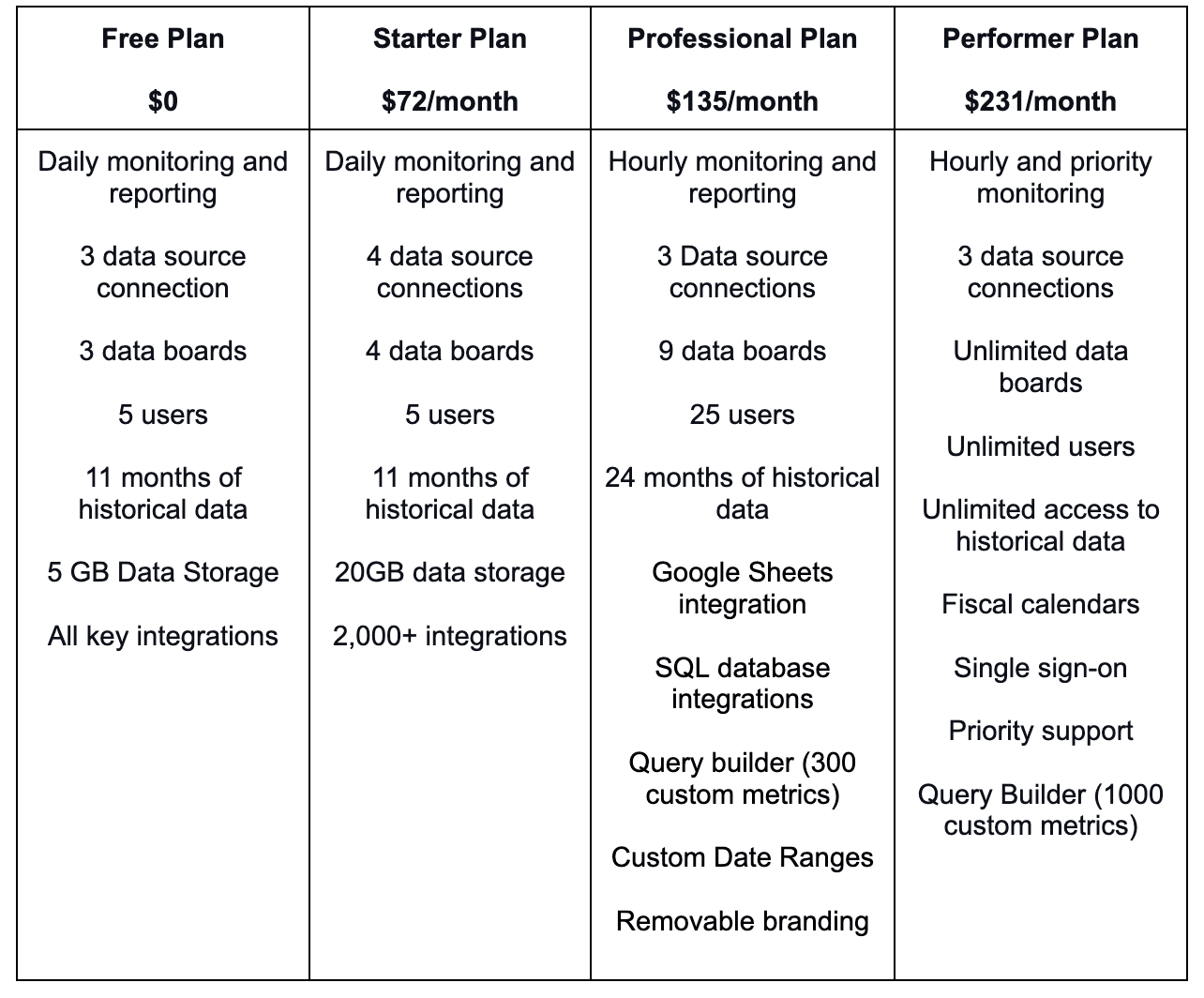
#1. Databox Free-Forever Plan
Databox free-forever plan offers daily monitoring and reporting of high-level metrics for small teams. However, the free-forever version has a lot more to offer.
With the free-forever plan, you get three data source connections and dashboards, respectively.
Moreover, the plan allows five users, daily data sync frequency, and upto 11 months of historical data accessibility.
Apart from this, the plan has over 12+ standard features, including:
-
Dashboard designer
-
Goal setting
-
Scoreboards and alerts
-
Scheduled snapshots
-
250+ public dashboard templates
Additionally, you can connect your data using 60+ pre-built databox integrations and create stunning visualization using its 2000+ third-party integrations with Zapier and Integromat.

But, with just three data source connections, you are limited to 5GB of storage space.
Drawbacks
Although Databox is a leading dashboarding software in the industry, it does have some drawbacks. We came across a few disadvantages backed by customer reviews. So let's get through them.
#1. Limited Data Source Connections
What's it like to build a dashboard without data? It doesn’t make sense, right?

Databox free-forever plan offers only three data connections, restricting data import from multiple platforms and applications storing your data.
#2. Doesn’t Support White-labeling
There's no white labeling included in the free version. Not even as an add-on. You have to carry the Databox branding throughout your dashboards and reports. So if you’re a marketing agency looking for white-label reports, you will have to purchase a paid plan.
#2. Databox Starter Pack
Like the free-forever plan, the starter plan offers daily monitoring and reporting of high-level metrics. It also has a trial period for paid plans - no credit card required.
However, the pricing is variable based on the required data connections. For example, you get four data source connections and dashboards at $72/month (if paid annually, otherwise $91/mo), six connections and dashboards for $76/month, and so on.

For the most part, the starter pack has everything that Databox’s free-forever plan offers, but of course, adding extra data source connections and dashboards is a plus.
Also, with the starter pack, you get 20 GB of storage and can personalize your dashboard with your business color palette and branding.
What’s more, you are allowed for a white-labeling add-on for $250/month.
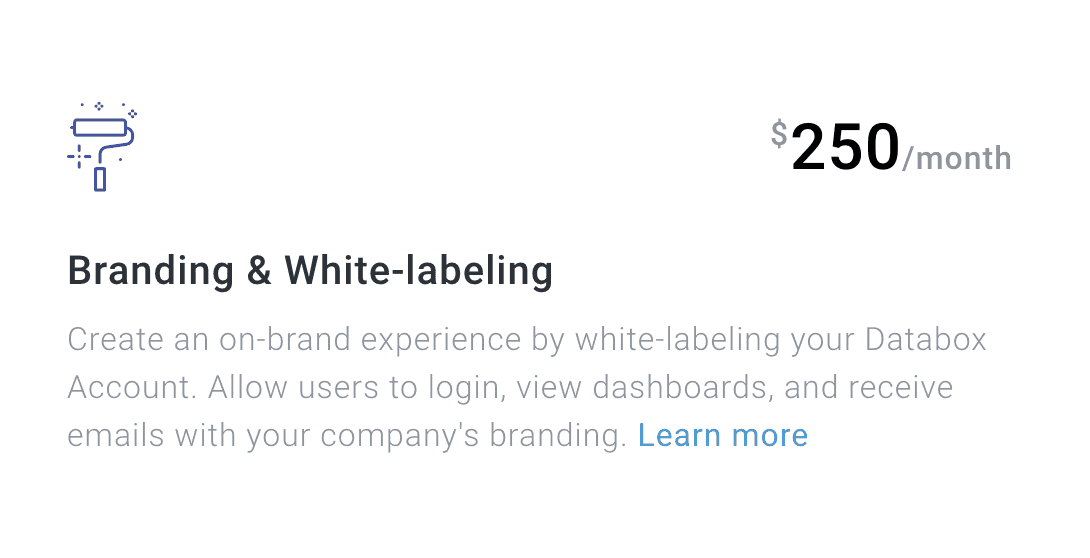
Drawbacks
#1. No-Free Google Sheets Integration
A significant drawback of the Databox starter pack is that you don't get google sheets integrations. One needs to upgrade to a higher plan to get it.

That's bizarre, considering that Google has a free dashboard called Google Data Studio (a competitor of Databox) that offers it for free.
#2. High Pricing
Comparably, Databox's starting price is higher than the average starting fee in the industry. Making it challenging for beginners to opt for its most basic paid plan.

#3. Does Not Support Query Builder
Databox free-forever and starter plans don't include query builders.
Query builder is a tool that helps users create custom metrics. With that being not available, creating custom metrics is not as easy as it seemed with Databox paid plans.

#3. Databox Professional Plan
Databox professional plan provides hourly monitoring and analysis of high-level metrics. The plan is best suited for small and medium-sized enterprises.
Initially, the professional plan includes three data source connections and nine dashboards at $169/month. As you increase the data sources, the pricing goes up.
The maximum you can go is 50 data connections and 150 dashboards, but this will cost you $357 per month.
Diving into the features, Databox professional plan includes every feature put along with the starter plan and some essential features like:
-
Google Sheets integration
-
SQL database integrations
-
Query Builder
-
Data Calculations
-
Custom Date Ranges
-
Removable branding
The query builder embedded with the plan allows you to create up to 300 custom metrics. Plus, you are free to select a custom date range.

Drawbacks
#1. Limited Customizations
We frequently came across reviews where customers were unsatisfied with Databox customization options.

While some customers find Databox unsuitable for non-technical guys, others were seen struggling to create eye-catchy visualizations and were unable to drill down data at par.

#2. Limited Integrations
With Databox, you are accustomed to certain limitations of third-party app integrations. For example, you can't integrate Ahrefs without custom development.

Moreover, some popular data source connections like Facebook AdManager are missing from the box.

#4. Databox Performer Plan
Databox's performer plan is your best option if you're serious about improving the performance of your business. It assists you with the on-demand monitoring of crucial metrics.
With 3 data source connections and unlimited dashboards, you can get the performer plan for $289/month. But, again, as you increase the number of data sources, the pricing increases significantly (maximum pricing: $571/month).
Unlike other subscription plans, the performer plans have no limitation to the number of users you onboard or the number of dashboards you create - it's unlimited.
Plus, the plan offers hourly and priority data sync frequency. The query builder embedded with this plan permits upto 1000 custom metrics allowing you to dive deep into the granular view of your business performance.
But that's not all. Databox's performance plan has more to it:
-
Activity-based Priority Sync
-
Fiscal Calendars
-
Supports Single Sign-on (SSO)
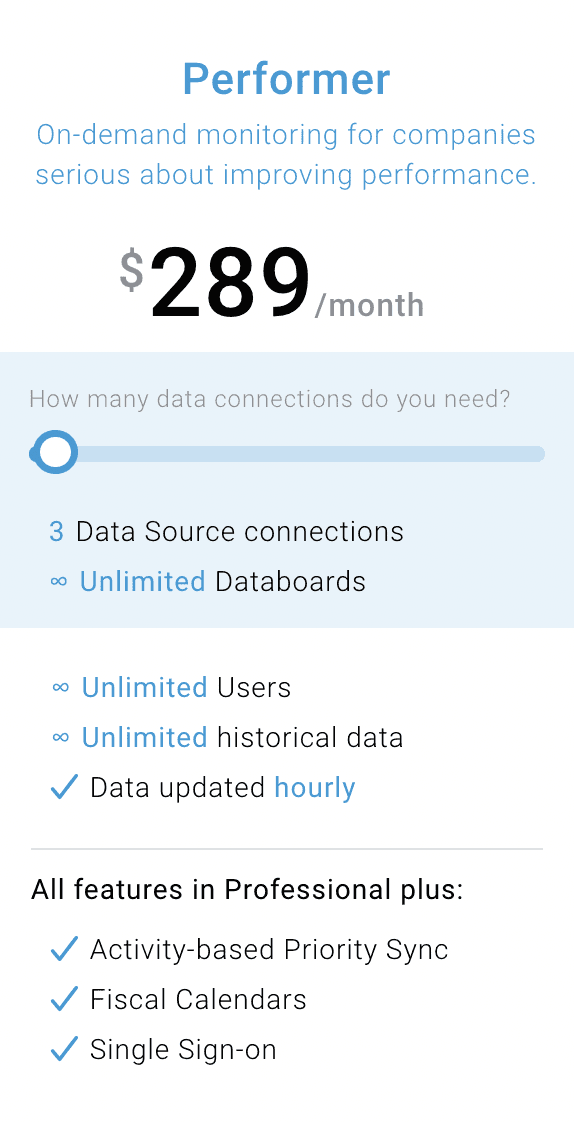
Drawbacks
#1. Bugs & Glitches
Even after paying a comparably higher price for Databox's subscriptions, the software is fond of bugs and glitches.

Although the bugs are fixed consistently by their customer support, there's no immediate solution to the problem.

Imagine creating the perfect dashboard and encountering glitches at the very end. No matter how good their customer support is, these minor errors hinder the overall workflow of businesses and teams.
Looking for a Databox Alternative?
Till now you might’ve got the idea about the pricing model of Databox. If you think it’s an expensive tool and want to explore your alternatives, here are some of them.

How Does Datapad Differ From Databox?
Unlike Databox, Datapad is a modern-day dashboarding and analytics tool that allows business owners to track, monitor, and analyze their business performance from their mobile phones.
When comparing the two, Databox has a higher learning curve than Datapad.
So as a beginner, if you're starting with Databox, you need to be patient for a week or two to understand Databox’s functioning. However, this isn't the case with Datapad.
Datapad comes with an easy-to-use interface allowing both technical and non-technical users to get the most out of their data.
Apart from the learning difficulties, there are certain aspects where Datapad has the upper hand over Databox. Let's get through them one by one.
#1. Mobile Optimization
Both Databox and Datapad mobile apps are available on Android and iOS stores. However, being accessible on both the web and the app, Databox fails to provide a wholesome pocket-friendly experience.
Here's what Nijo Daniel - one of Databox's mobile app users, has to say:

On the other hand, Datapad is specifically designed and optimized for mobile-first users. The app provides a simple, straightforward, and seamless mobile interface.
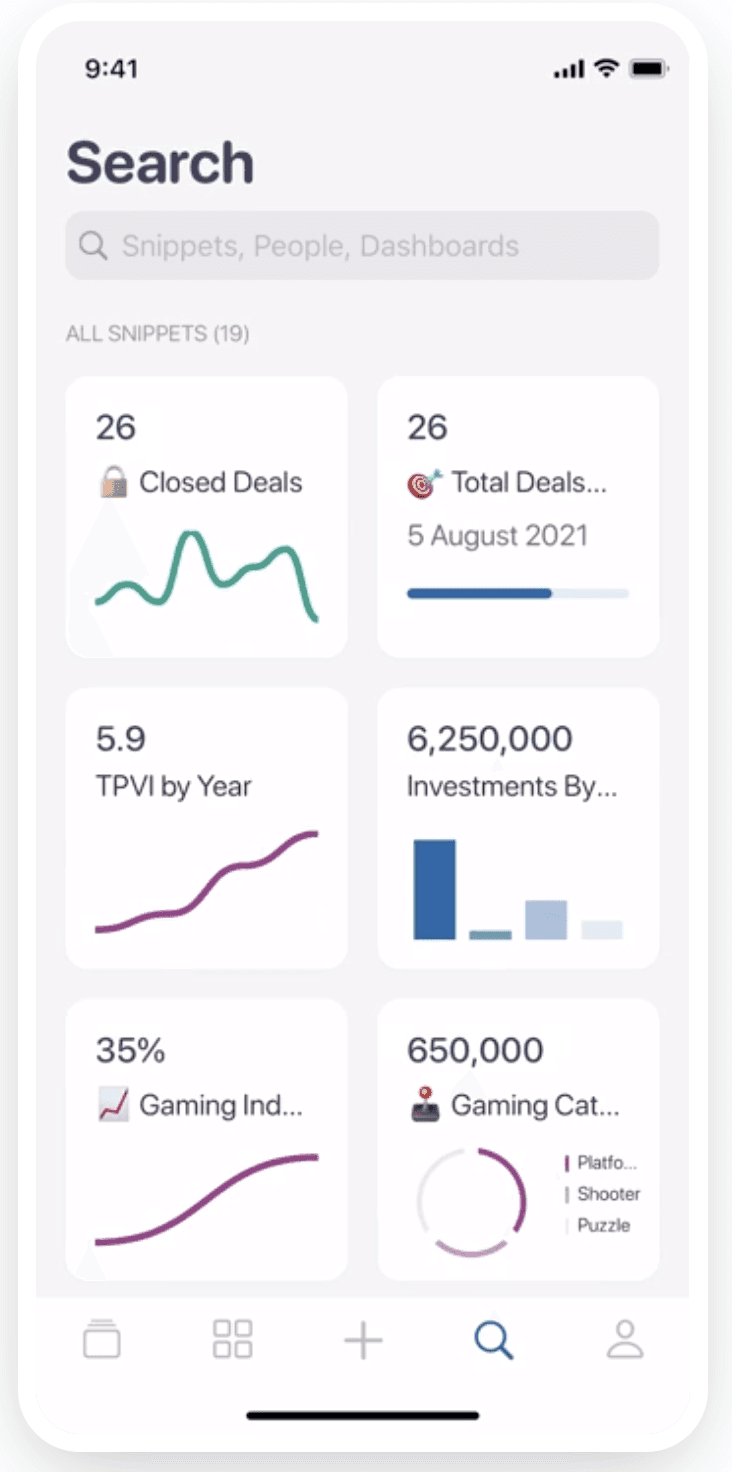
Moreover, Datapad's intuitive mobile technology disowns it from bugs and glitches, which you often encounter while using Databox.
#2. Team Onboarding
Databox has some great team onboarding features like setting permissions but the process might become tedious. As the platform has a higher learning curve, it might take some of your time to get your team on board.
Infact, it becomes overwhelming when your subordinates have to go through the same learning process before actually assisting you on Databox.
However, that's not the case with Datapad. The platform's intuitive design and functionality makes the onboarding process a piece of cake with minimal expertise. This saves you ample training time and allows your team to focus on work as soon as they get on board.
What’s more, Datapad eases team communication throughout its platform. For example, you and your teammates can comment below a particular metric to get your thoughts out quickly.

Datapad has an edge over Databox when it comes to onboarding team member, that’s because it lets you:
-
Set custom alerts and notifications regarding activities or trends in KPIs
-
Have seamless communication around complex metrics and KPIs with team members in real-time
-
Enable push notifications at regular intervals to stay updated with your KPIs and your team members’ performance
#3. Customizations
Customizations are the most sought-after feature for any dashboarding software. Unfortunately, going through the drawback mentioned above, you might have figured out that customization isn’t a strong suit of Databox.
But it does a decent job.
With Datapad, you can easily customize texts, add widgets, change the colors of metrics, and create custom dashboards as you desire.

#4. Data Import
Importing data into a business intelligence solution like Databox is restricted due to the limited number of data sources it offers with its subscription plans.
For example, with Databox’s paid plan, you get access to just three data source connections initially. If you want more, you have to pay more.
This often leads to an unaffordable pricing policy for many small businesses, startups, and medium-sized enterprises.
Moreover, even with the available data sources, the platform struggles to provide seamless import and export of crucial data.
Datapad, being a newcomer, has achieved ease of data import and export via multiple data sources and apis. Its well-built connectors (one-click integrations) help you import data to your Datapad dashboard effortlessly.
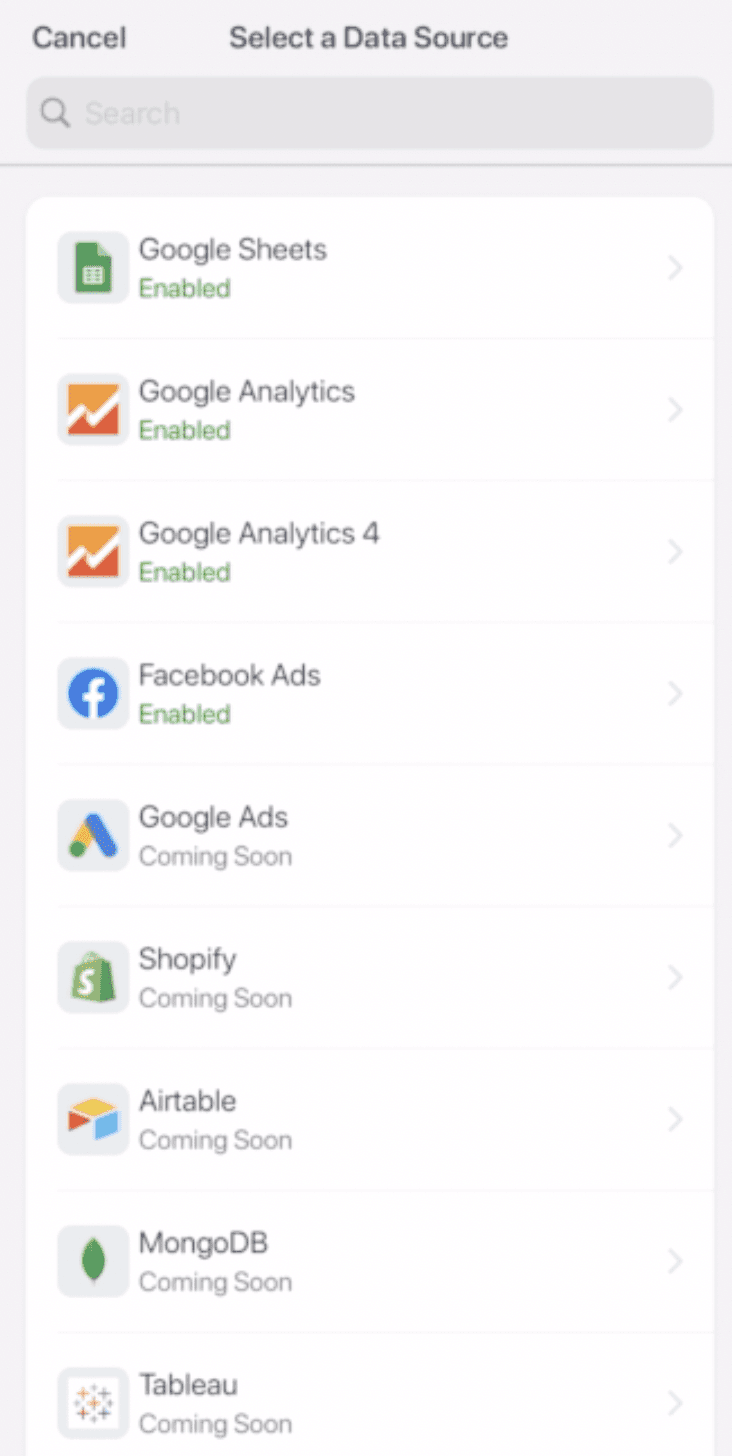
Datapad also offers you to import data via its AI assistant (automatically) or manually.
With Datapad's robust data integration, you can easily:
-
Automate your import and export of data, or do it manually
-
Easily customize your KPI dashboards to fit your data structure
-
Create custom metrics from data imported from various data points and set achievable goals or milestones
#5. Integrations
Another major differentiator between Databox and Datapad is their suite of integrations.
Although Databox owns the number of integrations (cloud-based and on-premise), it still fails to provide its users with access to some standard integrations. For example, integration to Google Sheets is only available with its paid plans.
Datapad gives you Google Sheets integrations and many others (Google Analytics, Shopify, Facebook Ads) for free.
Wrapping Up
Being in the market for a while now, Databox is a reliable business intelligence software, but why settle for less, if you can have more with other tools that more or less cost the same.
The Databox alternatives we mentioned in the article above are all tested, go ahead and try them out.
If you don’t want to give every alternative a try, we suggest you try out our mobile app - Datapad for free to create stunning databoards.
No matter if you're a startup, established SaaS brand, or an enterprise. We bet you won’t regret it!
Frequently Asked Questions (FAQs)
Q1.Is Datapad free?
Yes, our tool is free to use. Since Datapad is in its beta testing phase, you can book a 1-1 onboarding call and try it out for free.
Q2. How easy is it to get started with Datapad?
Datapad is designed with a user-centric approach. That means it's best suited for non-technical as well as advanced users. In addition, it's an absolute no-code platform allowing anyone to get their hands working on the platform within minutes.
Q3. Can I onboard my team?
Yes, Datapad is very particular when it comes to team onboarding. Because we know there's no success without seamless team collaboration. With Datapad, you can quickly onboard your team, assign tasks, and monitor your team's performance from anywhere around the world.
